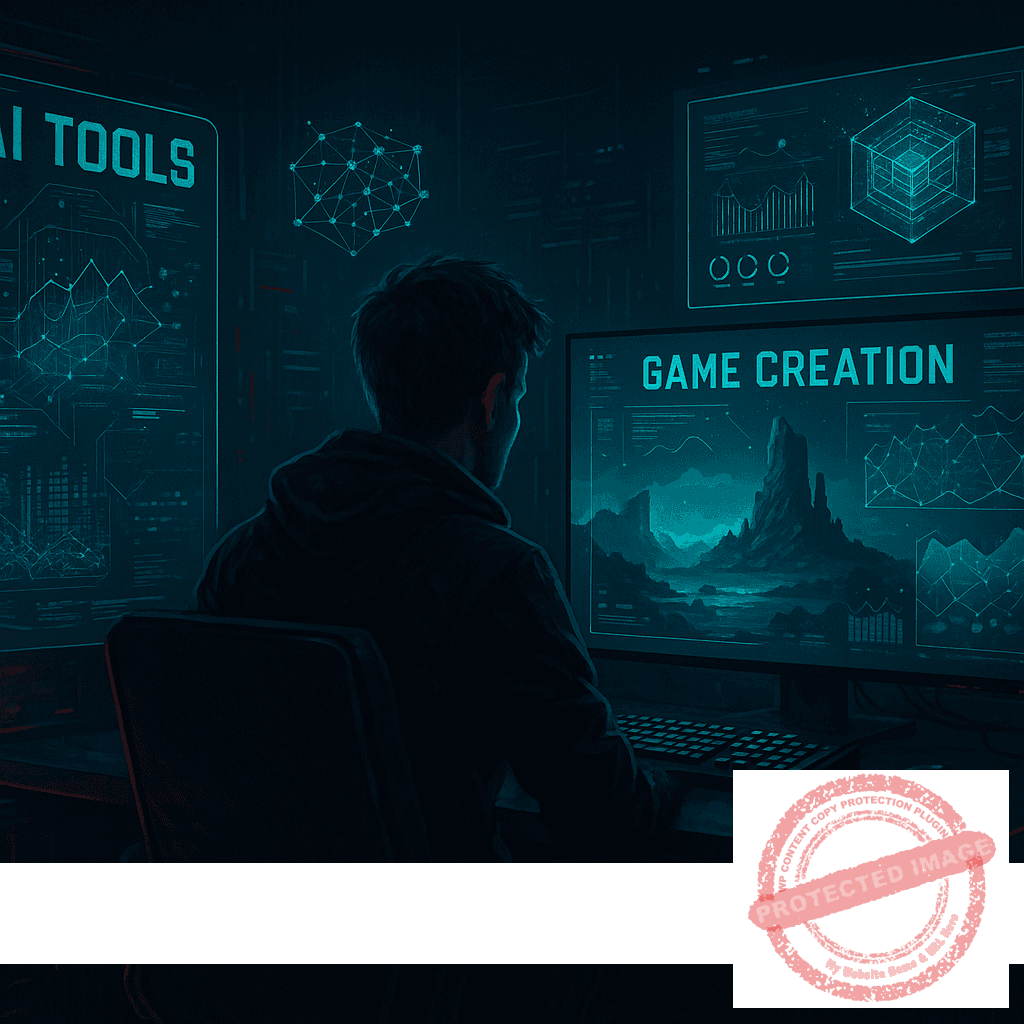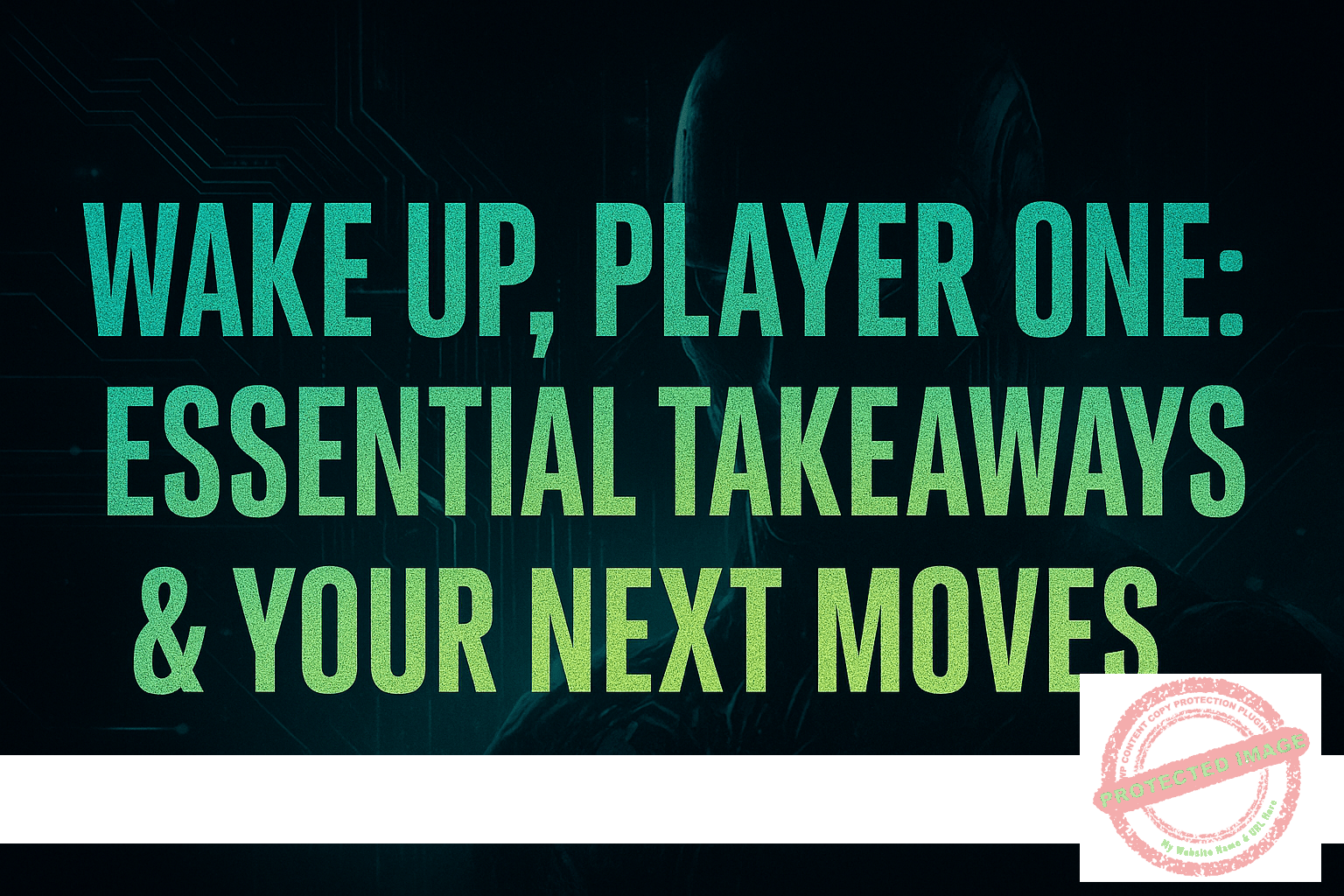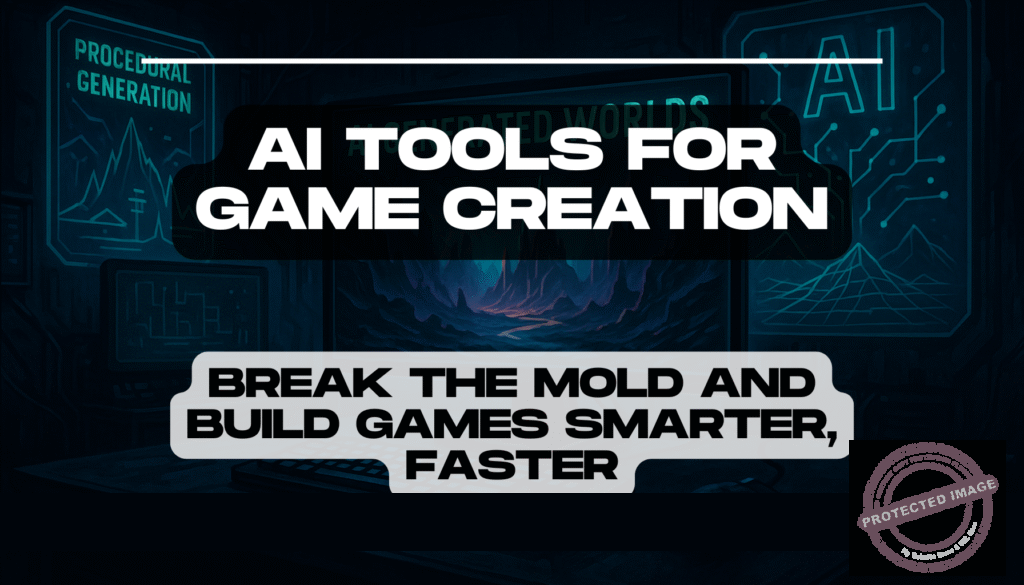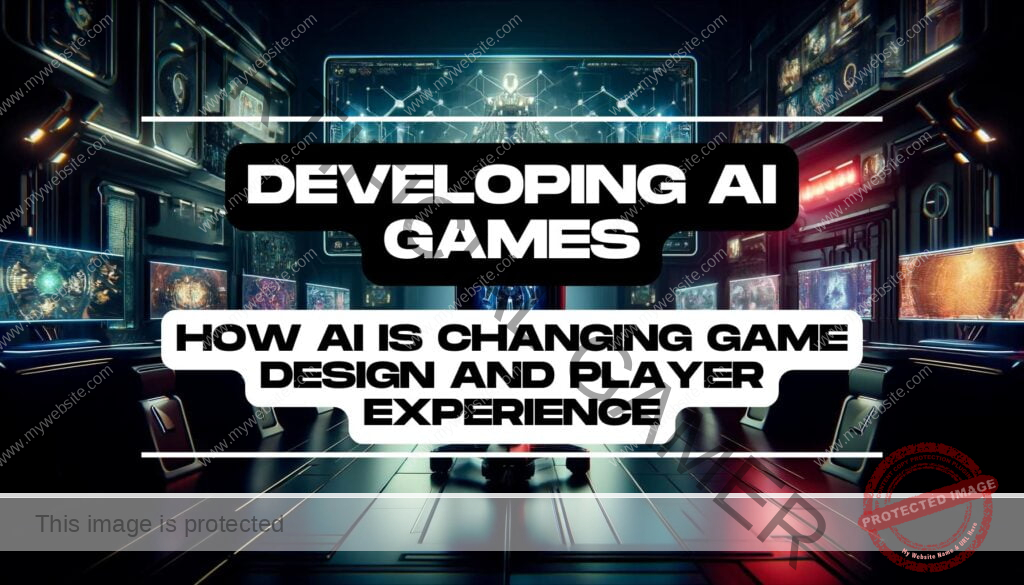Introduction: Why AI Tools for Game Creation Are the Red Pill You Need Right Now
Let’s drop the polite nonsense: if you’re still developing games the old way, you’re asleep at the wheel while AI tools for game creation are rewriting the rules of the industry. Every day you cling to your outdated pipelines and brute-force workflows, you’re falling further behind as artificial intelligence in game development evolves faster than most even realise. This isn’t just about saving time or pumping out prettier graphics — it’s about breaking free from the digital leash that’s been slipped around your neck by the same system that wants you docile, distracted, and obedient.
Look around: studios that dare to integrate AI-powered game engines, AI-based narrative systems, and AI tools for developers are launching games with procedurally generated worlds, smarter enemies, and dynamic stories that morph with player choices — all while you’re still stuck debugging your fourth static level map. And here’s the kicker: this isn’t some distant sci-fi future. The best AI tools for game creation are already here, quietly used by forward-thinking indie devs and juggernaut studios alike to crush deadlines, cut costs, and craft more immersive experiences than ever before.
You’ve been conditioned to believe AI will replace you, or that it’s too complex, or that it’s only for massive AAA studios with bottomless pockets. That’s exactly what they want you to think. But the real truth? By mastering AI tools for game creation, you can flip the script, outmaneuver the competition, and build smarter, faster, and more revolutionary games than those still chained to yesterday’s playbook. The question is: are you ready to wake up and take control?
Top AI Tools for Game Creation That Will Blow Your Mind
So you’re done warming up your brain — now it’s time to get your hands dirty with the AI tools for game creation that are flipping the industry on its head. These aren’t just flashy toys; they’re the secret weapons indie devs and AAA studios alike are using to build smarter, faster, and more immersive experiences while everyone else is busy patching old code and worshipping outdated workflows. If you’re serious about evolving beyond the herd, mastering these tools will turn you from a game dev hamster stuck on the same wheel into a creator who can shape worlds on your terms.

Generative Design Tools – Let AI Build Worlds While You Dream
Tools like Promethean AI and Scenario use advanced generative algorithms to help you create breathtaking environments, assets, and level layouts with minimal manual work. These AI tools for game creation empower you to design sprawling, complex worlds that feel alive — without spending years placing every rock and shrub by hand. They free your brain for big-picture creativity, not grunt work, and that’s exactly what Big Tech doesn’t want you doing.
AI-Powered Animation – Make Characters Move (and Think) Like Never Before
Say goodbye to lifeless animations. Solutions like DeepMotion and Cascadeur let you infuse your characters with dynamic, natural motion using AI-based rigging and motion capture refinement. These AI tools for developers don’t just save you weeks of tedious keyframing — they raise the bar on realism, making your NPCs react with spine-tingling believability. Because the faster your characters come alive, the faster you can get players questioning what’s human and what’s not.
AI Narrative Engines – Craft Stories That Adapt to Every Player
Forget linear plots that bore your players into a coma. Charisma.ai and Inworld AI bring branching narratives and responsive dialogues to life by using AI to adapt stories in real time based on player choices. These AI-powered game engines are the holy grail for developers who want to deliver replayability and emotional depth that feels tailor-made for every single player — a direct slap in the face of games that just shove everyone down the same hallway.
AI QA & Testing – Catch Bugs Before They Catch Your Reputation
Why spend months on manual testing when AI can comb your game for glitches, performance drops, and balancing issues faster and more accurately than your entire QA team? Tools like GameDriver and Applitools deploy AI algorithms to simulate thousands of gameplay scenarios, ensuring a rock-solid launch. With these AI tools for game creation, you can ship confidently without sacrificing your soul to crunch time
The Power of Integrating AI Tools into Your Workflow
These aren’t isolated silver bullets — together, these AI tools for game creation form a killer arsenal that transforms how you think about game design. But don’t get comfortable yet: understanding these tools is just the beginning of your journey to build smarter, faster, and more revolutionary games than the competition ever dreamed possible
For more on how AI is changing the very fabric of gameplay itself, check out our deep dive on AI-Enhanced Gaming Software: Revolutionizing Gameplay and Player Strategies.
How to Choose the Best AI Tools for Game Creation Without Falling for the Hype
Before you max out your credit card on every shiny AI subscription dangling in front of your eyes, stop and think: which AI tools for game creation will actually move the needle for your projects, and which are just overpriced fluff crafted to drain your wallet? Big Tech thrives on selling us solutions we don’t need, conditioning us to chase every new feature while our creative visions rust in the background. It’s time to slice through the hype and pick AI tools that truly serve your goals — not the goals of the companies programming your spending habits.
Core Features to Demand from AI Tools for Game Creation
Don’t settle for vague marketing promises. The best AI tools for game creation should have crystal-clear capabilities like advanced procedural generation, intelligent asset optimisation, seamless integration with your existing game engine, and robust AI-driven analytics. If a tool can’t show you tangible, repeatable results in these areas, it’s a time-wasting toy — not a strategic asset.
Hidden Costs and Pitfalls That Can Crush Indie Developers
Most AI tools for developers won’t warn you about sneaky usage limits, pay-per-export traps, or licensing clauses that siphon royalties from your game’s future earnings. Always dig deep into the pricing structures, read the fine print, and question whether the tool’s cost scales sustainably with your ambitions — or whether it’ll bleed you dry as your player base grows. Remember: financial freedom is a key ingredient in building games that challenge the system.
Matching AI Tools with Your Studio’s Size, Budget, and Vision
A solo dev hammering away on a shoestring budget doesn’t need the same AI toolkit as a studio with twenty artists and a publisher breathing down its neck. Smaller teams should prioritise lightweight, modular AI-powered game engines or plug-ins that reduce production time without drowning them in complexity. Larger studios can afford comprehensive AI suites — but must ensure these tools actually enhance collaboration and don’t bog the team down in redundant automation
Putting the Hype to the Test in Your Workflow
Every marketer will tell you their AI tool will revolutionise your life. Prove them wrong — or right — by integrating free trials or open-source alternatives into a small-scale prototype. If the AI consistently saves you time, improves quality, and unleashes creative options you couldn’t dream up alone, you’ve got a winner. Otherwise, drop it before you waste another day chasing promises and start focusing on building smarter, faster, and more revolutionary games with tools that truly earn their keep
Learn how to future-proof your skills with our comprehensive guide on AI Tools for Game Developers: How to Stay Ahead of the Game with Cutting-Edge Tech.
Real-World Success Stories: Games That Leveraged AI Tools for Creation
Talk is cheap, but shipped games don’t lie. While most developers are still chained to outdated processes and praying their next patch won’t break the game, a new breed of studios is already wielding AI tools for game creation to build worlds that feel alive, stories that react like sentient beings, and gameplay that constantly evolves with the player. These pioneers prove it’s not theory or marketing spin — it’s happening right now, and it’s shaking the foundations of the industry harder than the clueless gatekeepers want to admit.

How No Man’s Sky Used AI to Forge a Limitless Universe
Before the infamous rocky launch, Hello Games’ ambition was unprecedented: a procedurally generated galaxy with 18 quintillion planets, each teeming with unique ecosystems. Powered by advanced generative design tools, No Man’s Sky leveraged AI algorithms to create a universe so vast and varied it would take lifetimes for players to explore. Despite its early stumbles, ongoing updates have refined the AI systems, proving that the right AI tools for game creation can build an ever-expanding playground that keeps players hooked for years.
Shadow of Mordor’s Nemesis System: AI That Remembers and Evolves
Monolith Productions flipped the script with Shadow of Mordor’s Nemesis System, a groundbreaking example of AI-powered game engines crafting dynamic stories. The AI-driven orc hierarchy remembered every interaction with the player — victories, humiliations, and betrayals — creating unique rivalries that gave each playthrough its own narrative. This approach transformed standard hack-and-slash gameplay into a personal saga that challenged players to think strategically about every encounter.
AI-Enhanced Level Design in Spelunky’s Procedural Worlds
Indie darling Spelunky used AI-inspired procedural generation to craft endless cave layouts that felt handcrafted. By harnessing AI tools for developers, creator Derek Yu created a system that balanced randomness with carefully designed challenges, ensuring every run offered fresh experiences. This mastery of AI-driven level design proved that even solo devs can harness AI tools for game creation to punch way above their weight class and deliver replayability that puts bigger studios to shame.
The Indie Studio That Used AI Dialogue to Create Reactive NPCs
In the noir-inspired adventure game Eliza, indie studio Zachtronics integrated AI-powered narrative tools to simulate natural, branching conversations with emotionally complex NPCs. This bold use of AI made each player’s therapy sessions feel authentic and unpredictable, proving that even in story-heavy genres, AI tools for game creation can inject humanity, depth, and replay value that flat, pre-scripted dialogue trees simply can’t compete with
Learning from the Pioneers to Build Smarter, Faster, Revolutionary Games
These success stories aren’t isolated flukes — they’re your blueprint. By studying how these teams used AI to amplify creativity instead of replace it, you can sidestep the same mistakes, dodge the hype traps, and turn AI from a buzzword into your ultimate creative partner as you forge your own path into gaming’s future
Future-Proofing Your Workflow with AI Tools for Game Creation
If you think mastering today’s AI tools for game creation is enough to stay ahead, you’re already falling behind. The truth is the game industry’s AI landscape mutates faster than most developers can refresh their LinkedIn profiles, and the only way to survive is to build a workflow that evolves with it. Future-proofing isn’t about latching onto the latest buzzword — it’s about architecting a mindset and development pipeline that adapts faster than the market can shift beneath your feet.

Key AI Trends Set to Reshape Game Development Over the Next Five Years
Procedural storytelling that personalises every questline, AI-driven economies that react to real-time player behaviour, and generative voice synthesis that gives NPCs unique personalities — these aren’t far-off dreams. They’re on the cusp of mainstream adoption. By studying trends like deep reinforcement learning, AI art iteration, and cross-modal AI (combining text, audio, and visual generation), you can anticipate how AI tools for game creation will explode in capability and complexity.
Building an Adaptable, AI-First Development Pipeline
You don’t need a bloated corporate team to create an agile AI-first workflow. Start by modularising your processes so AI tools can slot in and out without derailing your entire pipeline. Prioritise tools with robust APIs and flexible integrations, empowering you to swap outdated solutions for bleeding-edge replacements without rewriting your whole engine. This adaptability is the difference between thriving and getting crushed when the AI tide inevitably shifts.
Staying Ahead of the Curve While the Competition Sleeps
The world is filled with developers who snooze through paradigm shifts until they wake up obsolete. Don’t join them. Carve out regular time to experiment with new AI tools for game creation, stay plugged into AI research communities, and challenge your assumptions about what AI can do for your genre. By fostering a culture of relentless curiosity, you won’t just keep pace — you’ll set it, ensuring your games evolve smarter, faster, and more powerfully than the stale clones flooding the market right now
Integrating AI Ethically to Protect Creativity and Player Trust
Building the future isn’t just about tech — it’s about responsibility. As you adopt AI tools for developers, design systems that respect player data privacy, maintain creative integrity, and avoid exploitative mechanics. A future-proofed workflow bakes ethics into every AI decision, because players will reward developers who respect them with long-term loyalty and word-of-mouth buzz that no marketing budget can buy
According to industry insights from Gamasutra’s latest report on AI in game development, staying informed about evolving AI trends is crucial to staying competitive.
Mind Hackers’ Manual: Answering the Burning Questions About AI Tools for Game Creation
You’ve seen the power of AI tools for game creation, but let’s be real: questions are probably exploding in your head faster than a rage-quitter’s keyboard. The system banks on you being confused and hesitant, so you’ll stick with the same stale tools everyone else uses. But ignorance isn’t bliss — it’s a cage. This section demolishes the most common myths and gives you unfiltered answers to the biggest questions keeping developers stuck in the past, so you can break free and start building smarter, faster, and more revolutionary games today.
Can AI Really Replace Human Creativity in Game Design?
Short answer: no. Long answer: AI can augment your creativity by handling repetitive tasks, suggesting unexpected ideas, and optimising processes — but it can’t replace your instinct, emotional nuance, or unique vision. The best AI tools for game creation act like supercharged assistants, not replacement artists.
Are AI Tools for Game Creation Only Useful for Big Studios?
Absolutely not. Indie developers have the most to gain because AI can do the heavy lifting once reserved for massive teams — from generating assets to automating dialogue trees. Many top AI tools for developers scale beautifully with smaller projects, letting indies compete with studios 100 times their size without selling their souls.
Will AI Tools Really Speed Up Development Without Sacrificing Quality?
When used strategically, yes. The key is avoiding blind automation: don’t hand everything to AI. Use it for time-sucking tasks like procedural generation, level testing, and character rigging so you can focus your energy on polish, story, and gameplay innovation. That’s how smart devs build AI-powered game engines that outpace traditional pipelines.
What Ethical Risks Should I Consider When Using AI in Games?
AI is a double-edged sword: it can empower you or exploit your players if misused. Be wary of implementing AI systems that manipulate players into compulsive spending or misuse personal data. Future-proof your reputation by baking ethical guidelines into your workflow from day one, ensuring your AI tools for game creation respect both your creative integrity and your players’ trust
How Do I Keep Up with the Fast-Moving World of AI in Game Development?
Plug into AI and game dev communities, follow research from reputable sources like GDC, Unity, and Unreal, and keep experimenting with new tools on side projects. Don’t let your workflow calcify. Those who stay curious and adaptable will always be the ones rewriting the rules instead of reading outdated manuals drafted by gatekeepers who want you asleep at the wheel
Wake Up, Player One: Essential Takeaways & Your Next Moves
If you’ve made it this far, you’re already ahead of the herd — but knowledge without action is just another way to stay asleep. The world of AI tools for game creation isn’t waiting for your permission to transform game development; it’s happening right now, and only those bold enough to adapt will stay relevant as the industry shifts under their feet. These takeaways aren’t just bullet points — they’re your marching orders to break free from outdated workflows, challenge your assumptions, and start building games that shatter expectations.
Arm Yourself with the Three AI Tools You Need Today
Focus on tools that turbocharge your core workflow: generative design tools to build immersive worlds faster, AI-driven animation systems for lifelike characters, and narrative AI engines to craft stories that evolve with players. Mastering these AI tools for game creation will unlock creativity you didn’t know you had.
Don’t Just Understand AI’s Role in Gaming — Exploit It
Passive consumption is how you get played. Use what you’ve learned to dissect how competitors apply AI in their titles, spot trends before they go mainstream, and position your games as the smartest, fastest-evolving experiences on the market. The difference between players and pioneers is who controls the tools — and who lets the tools control them.
Take Action: Build Smarter, Faster, and More Revolutionary Games
Make a commitment today to integrate one AI tool into your next project, no matter how small the experiment. Track how it transforms your speed, quality, and creative options. Then iterate, scale, and share your discoveries. By turning theory into action, you’ll gain real-world experience that can’t be downloaded from a tutorial — and carve your own path to game dev mastery as everyone else sleeps at the keyboard
Join the Community of Independent Thinkers Redefining Game Creation
Don’t go it alone. Connect with fellow developers who see AI as a means to liberation, not a threat. Share insights, trade feedback, and collectively push the boundaries of what’s possible with AI tools for game creation. The revolution won’t come from corporations spoon-feeding safe innovation — it’ll come from creators like you, willing to question everything and redefine what games can be


